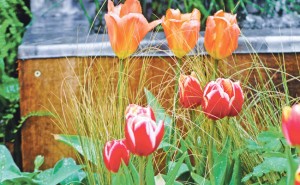Last month’s article made reference to the impending spring tasks relating to lawn care and restoration. At this time of year it is easy to become distracted by the colour of spring bulbs, early flowering shrubs and fresh green emerging foliage.
Often ignored and misunderstood, there is no doubt that the lawn plays a major part in providing an area for relaxation, but which other plant can you cut to the ground every week or so and yet expect it to be lush green and void of competition from weeds and moss.
If you don’t spike your lawn every year it can lead to over compaction and waterlogging, this is fairly easy to resolve using a garden fork. Push the fork into the lawn to a depth of 100 – 150mm (4 to 6 inches) and about every 100mm (4 inches) apart. This can take some time but is well worth the effort. On larger areas you can hire a powered machine to do the job.
The vast majority of gardeners use rotary mowers which have a single blade that spins and projects most of the grass clippings into a rear mounted grass box, whilst they are quite efficient there is a proportion of the clippings that fall back onto the lawn which over time can cause a build-up of what we call thatch (dead grass) if you rake the lawn lightly with a wire rake every month this will reduce the build-up and encourage healthier grass growth.
Feeding is generally done twice per year, once in spring to encourage new growth and a lush green appearance, late in the season an autumn feed is applied which helps the grass to build up a good root system and harden up for the impending cold weather. These feeds can be obtained with weed and moss killers included, I prefer to treat for weeds and moss separately but if you have a busy life you may find them easier to use. Always read and follow the instructions carefully.
If you need to repair areas of your lawn then turf is by far the quickest but does require a little skill to prepare the area to ensure the lawn remains level and even. For small irregular areas I prefer to use seed mixed with a little soilless compost and pre-germinated, place two good handfuls of seed into five litres of compost, use an old compost bag which will exclude the light and shake the mix together. Place in a cool greenhouse or utility room and after about ten days you should see the seed just starting to grow. Lightly rake the area you are seeding and spread a thin layer of the mix over the surface and firm gently and water in. This method avoids problem of birds eating the seed.
Next month we will look at annual flower and vegetable crops, especially suited to small spaces.
Happy gardening,
Martin
York Gate Garden is owned and maintained by the charity Perennial (Gardeners Royal Benevolent Society)which provides advice help and support in times of need or difficulty for people who are working in, or have retired from any of the gardening trades. (Registered Charity no. 1155156).
Opening times and further details can be found on our website at www.perennial .org.uk







